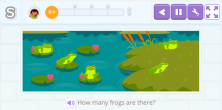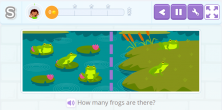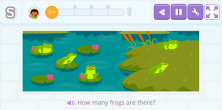When thinking about math in the early years, math for little ones, we contemplate counting, first numbers, and acquiring numerical sequence. And indeed, it is at this stage where we begin to develop the ability to count.
But these are not the only math topics that children can learn in the early years. There is much more math content that can be addressed from a very young age that will allow children to move easily into more complex content.
How many are there?
This is a very typical question when learning math in the early years – ‘How many are there?’ And depending on the situation, there are an infinite number of possibilities.
Let’s look at this activity for a moment:

At first glance, it can seem like a typical counting task. Any exercise where we expect the child to point to each one of the elements on the screen while going through the number sequence and ending with a written or oral number. ”One, two, three, four, five. There are five.”
However, if we stop to observe it in detail, it has some special characteristics and has been carefully designed to favor a wide range of processes.

Configuration
This activity has two distinct parts and the design was inspired by Remi Brissiaud’s game.
On the left side, there are individual containers (water lilies) and elements (frogs) and nothing on the right side. The containers are organized in a familiar way. I’m sure if we look at some other examples you will be able to recognize it.
Do you recognize the configuration of these elements?

They are arranged like dots on dice! Great job!
Back to the frogs!
The way that the containers (water lilies) and elements (frogs) are placed on the left side promotes subitizing. But on the right side, when the elements (frogs) are outside of the containers, they are presented in a disorganized way.
It is common to think that it is necessary to know the name or how to spell numbers in order to answer the question. However, the truth is that at an early stage, a very young child could give us the answer using dice. Children could rely on the similarity of the configuration and answer our question without knowing the numerals, thanks to number sense.

Similarly, children can answer the questions using their fingers because, even though the left side is arranged like dice, it is always based on the number 5. This also facilitates the connection between the numbers and fingers on a hand.

For example, let’s take a look at 6, 7 or 8.

The elements can be presented in many ways. All on the left. All on the right. Or distributed on both sides representing all the ways to break down the number. This promotes understanding of the part-whole concept.

Animation
If the elements are animated, the trajectory can be seen and it is a great way to introduce children in early childhood education to solving math problems. Children can see an initial amount, a shift of some elements, and how many there are in total, how many were taken away, how many are left can be asked for… The child should choose the best strategy to find the answer based on their knowledge. They can see the full containers, the empty ones, and compare the two. They can also see the items that are outside of the containers, carefully follow the movement of the elements and keep track of them with their fingers, etc.
Incorporating Numerals
So far knowing the numerals hasn’t been a requirement to address mathematical concepts. But what happens when they have already acquired the number sequence and know them?
This same activity can be completed with a part-whole diagram. The diagram depicts the situation from the image and is an opportunity to lay the foundation for additive decomposition.

And later on, moving to increasingly more abstract areas, the information collected on those diagrams can be translated into symbolic expressions.

And all of this started with How many are there?
At Smartick, children will find these early years activities and more exercises and content to help them learn elementary math. Don’t hesitate to sign up and take advantage of our free trial.
Learn More:
- Roman Numerals: Do You Know How to Add Them?
- Learn How to Use Roman Numerals
- Practising Roman Numerals
- Learn How to Subtract with Examples
- Learn New Tricks to Memorize Multiplication Tables!







